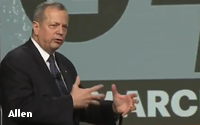Expert Reveals Dark Side Of 'Dark Social,' Says Messaging Apps Enable Terrorist 'Command And Control'
- by Joe Mandese @mp_joemandese, March 12, 2016
 AUSTIN, TEXAS -- At a time when tensions between the
military intelligence community and the digital technology industry appear to be high, retired U.S. Marine Corps General John Allen outlined how successfully the two have been working together to
combat how Islamic extremists have been using digital media to recruit foreign fighters and command and control their operations.
AUSTIN, TEXAS -- At a time when tensions between the
military intelligence community and the digital technology industry appear to be high, retired U.S. Marine Corps General John Allen outlined how successfully the two have been working together to
combat how Islamic extremists have been using digital media to recruit foreign fighters and command and control their operations.
During a keynote at the SXSW Interactive festival here, John Allen, who served as special presidential envoy to the Global Coalition to Counter ISIL, equated the Islamic extremists’ adaption of digital media to the innovative way they exploited simple technology to develop IEDs (improvised explosive devices) to battle U.S. troops in Iraq.
And just as IED technology has been exported to other battlegrounds, Allen predicted Islamic extremists would continue to spread their presence globally through digital media.
advertisement
advertisement
Allen, who is now a senior strategic advisor at PwC, estimated ISIL or Daesh has successfully utilized digital media to recruit 30,000 foreign fighters, but that the Global Coalition has begun countering those efforts via a three-pronged strategy involving partners in 64 countries.
1 - Counter the narrative.
2 - Deploy a counter narrative.
3 - Most importantly, deny the platform.
He said the primary means of achieving the first two steps involves creating content, especially content generated by people in local Islamic communities.
“Someone who looks like me or talks like me has zero influence,” Allen conceded, seconding a point made during President Barack Obama’s SXSW keynote on Friday, that such messaging has to be “authentic” and cannot come from the American intelligence community, but from the Islamic culture itself.
Allen cited two centers -- in the United Emirates and one in Nigeria -- and one soon to open in Malaysia that have effectively begun spreading a counter narrative against Daesh’s messages. Inside the U.S., he said the government has been working with local Islamic groups to help inform parents and community leaders on the techniques being utilized by Daesh and advising them on how to counter the messaging.
In terms of the third goal of “denying the platform,” he said the main focus so far has been working directly with big digital media companies like Twitter to simply deny Daesh operatives access to the service. He said those efforts have already become successful and the number of tweets being distributed has begun to fall.
Perhaps the most controversial part of Allen’s presentation to the tech community was how the U.S. Cyber Command has begun to work on methods to deny Daesh its ability to utilize peer-to-peer media to reduce its ability to “command and control” the foreign fighters it recruits and deploys for terrorist activities.
He said the main focus has been on “recent phone apps” that have “permitted Daesh to go dark.”
Allen said that once Daesh has successfully recruited an individual, it redirects them to “one of the commercially available phone applications where they go dark and we can no longer see them.”
He said it was the use of such peer-to-peer messaging apps that enabled Daesch to command and control operatives during the Paris and San Bernardino attacks.
“This is a real challenge now,” he said, “The global command and control that can be affected through these means represents a real challenge for us.”
Allen did not address the government’s efforts to get Apple to give it access to the San Bernardino terrorist’s iPhone, but he alluded that it’s not just an encryption issue, but a “legal issue.”

